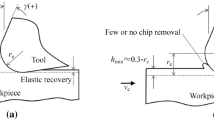Abstract
In this paper, the 5-axis tool path that has been generated on the cutter contact (CC) surface is generated on the cutter location (CL) surface, and the CL surface deformation approach that inversely deforms the 3-axis tool path generated on the deformed CL surface to a 5-axis tool path is introduced. The CL point computation and interference check based on the CL surface is faster and more robust than that based on the CC surface. The proposed CL surface deformation approach can be used if the orientation of the cutter is predefined. By the CL surface deformation approach, the 5-axis tool path generation time can be reduced to that of a 3-axis, since the complexity of a CL surface deformation is linear and because the 3-axis tool path generation and gouge removal algorithms are used at the deformed CL surface .
Similar content being viewed by others
References
Marciniak K (1987) Influence of surface shape on admissible tool positions in 5-axis face milling. Comput Aided Des 19(5):233–236
Li F, Wang XC, Ghosh SK, Kong DZ, Lai TQ, Wu XT (1995) Tool-path generation for machining sculptured surface. J Mater Process Technol 48(1–4):811–816
Lee YS (1997) Admissible tool orientation control of gouging avoidance for 5-axis complex surface machining. Comput Aided Des 29(7):507–521
Baptista R, Simoes JFA (2000) Three and five axes milling of sculptured surfaces. J Mater Process Technol 103(3):398–403
Gray P, Bedi S, Ismail F, Rao N, Morphy G (2001) Comparison of 5-axis and 3-axis finish machining of hydroforming die inserts. Int J Adv Manuf Technol 17(8):562–569
Young HT, Chuang LC (2003) An integrated machining approach for a centrifugal impeller. Int J Adv Manuf Technol 21(8):556–563
Sing S, Mannan MA, Poo AN (2004) Oriented bounding box and octree based global interference detection in 5-axis machining of freeform surfaces. Comput Aided Des 36(13):1281–1294
Ho S, Sarma S, Adachi Y (2001) Real-time interference analysis between a tool and an environment. Comput Aided Des 33(13):935–947
Choi BK, Kim KH, Jerard RB (1997) C-space approach to tool path generation for die ans mould machining. Comput Aided Des 29(9):657–669
Morishige K, Takeuch Y, Kase K (1999) Tool path generation using C-space for 5-axis control machining. ASME 121:144–149
Jun CS, Cha KD, Lee YS (2003) Optimizing tool orientations for 5-axis machining by configuration-space search method. Comput Aided Des 35:549–566
Yang W, Ding H, Xiong Y (1999) Manufacturability analysis for a sculptured surface using visibility cone computation. Int J Adv Manuf Technol 15(5):317–321
Balasubramanian M, Laxmiprasad P, Sarma S, Shaikh Z (1999) Generating 5-axis NC roughing paths directly from a tessellated Representation. Comput Aided Des 32:261–277
Balasubramanian M, Sarma SE (2003) Collision-free finishing toolpaths from visibility data. Comput Aided Des 35:359–374
Choi BK, Kim DH, Jerad RB (1997) C-Space approach to tool path generation for die and mold machining. Comput Aided Des 29(3):657–669
Jun CS, Kim DS, Park SH (2003) A new curve-based approach to triangle machining. Comput Aided Des 34(5):379–389
Park SC (2004) Sculptured surface machining using triangular mesh slicing. Comput Aided Des 36(3):279–288
Lee BK, Lee YS (2002) Non-uniform offsetting and hollowing objects by using biarcs fitting for rapid prototyping process. Comput Ind 47:1–23
Qu X, Stucker B (2003) A 3D surface offset method for STL-format models. Rapid Prototyp J 9(3):133–141
Kim SJ, Lee DY, Yang MY (2004) Offset triangular mesh using the multiple normal vectors of a vertex. Comput Aided Des Appl 1(1–4):285–292
Choi BK, Jerard RB (1998) Sculptured surface machining theory and application. Kluwer, Dordrecht, pp 224–247
Galyean TA, Hughes JF (1991) Sculpting: an interactive volumetric modeling technique. SIGGRAPH 25:267–274
Ratchev S, Govender E, Nikov S, Phuah K, Tsiklos G (2003) Force and deflection modelling in milling of low-rigidity complex parts. J Mater Process Technol 143–144:796–801
Lee CS (1996) Surface modeling and 5-axis NC machining of automobile tire model. J Korean Inst Ind Eng 9(2):129–141
Cho JG, Kim NJ, Woo HJ, Park HP, Lee KH (1999) Construction of 3D tire models from pattern drawings. ’99 CAD/CAM Conference, Seoul, Korea
Jung YH, Lee DW, Kim JS, Mok HH (2002) NC post-processor for 5-axis milling machine of table-rotating/tilting type. J Mater Process Technol 130–131:641–646
Author information
Authors and Affiliations
Corresponding author
Rights and permissions
About this article
Cite this article
Kim, SJ., Lee, DY., Kim, HC. et al. CL surface deformation approach for a 5-axis tool path generation. Int J Adv Manuf Technol 28, 509–517 (2006). https://doi.org/10.1007/s00170-004-2392-0
Received:
Accepted:
Published:
Issue Date:
DOI: https://doi.org/10.1007/s00170-004-2392-0




